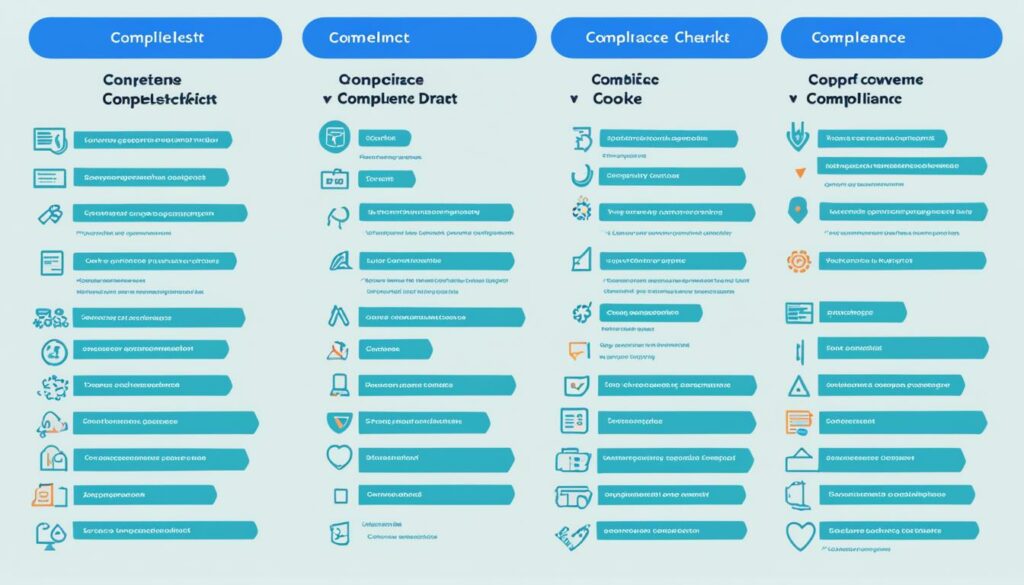Bandwidth and storage are essential factors that significantly impact the performance and user experience of your website. Understanding their role in hosting is crucial for optimizing your website’s speed, scalability, and overall efficiency.
Bandwidth refers to the data transfer capacity of a network and determines how quickly data can be transferred between your website and its visitors. It plays a vital role in ensuring fast loading times, smooth browsing experiences, and improved search engine optimization. On the other hand, storage refers to the amount of data that can be stored on a server, affecting the total capacity and capabilities of your website.
In this article, we will delve into the importance of bandwidth and storage in hosting and provide you with valuable insights and best practices for optimizing their usage. By understanding the role they play and implementing effective strategies, you can enhance your website’s performance, user experience, and ultimately drive greater success for your online presence.
Key Takeaways:
- Bandwidth and storage are crucial factors that affect website performance and user experience.
- Bandwidth determines the speed at which data is transferred between your website and its visitors.
- Storage capacity impacts the amount of data that can be stored on your server.
- Optimizing bandwidth and storage usage is essential for a fast and reliable website.
- Implementing best practices can improve website performance and cost efficiency.
What is Bandwidth and Why is it Important for Your Website?
Bandwidth is a vital component of your website’s performance and user experience. It refers to the maximum rate of data transfer across a network and is measured in bits per second. Simply put, bandwidth determines the speed at which data can move between your website and its visitors.
Having sufficient bandwidth is crucial for ensuring fast-loading webpages and a seamless browsing experience. When your website has limited bandwidth, it can result in slow loading times, leading to frustrated visitors and potential loss of organic traffic. Slow-loading websites also have a negative impact on search engine optimization, as search engines prioritize fast-loading sites in their rankings.
By optimizing your website’s bandwidth, you can enhance its overall performance and user experience. This includes minimizing loading times, reducing buffering for multimedia content, and improving search engine rankings.
Bandwidth: A Key Factor in Website Performance
Website performance is heavily reliant on bandwidth. When visitors access your site, the data packets containing web content are transmitted from your server to their devices. The speed and efficiency of this transfer depend on the available bandwidth.
Inefficient use of bandwidth can lead to slow-loading webpages, resulting in a poor user experience and decreased website performance.
Moreover, modern websites often feature multimedia content like images, videos, and interactive elements. These elements require a significant amount of data to be transferred, making adequate bandwidth even more crucial to ensure smooth loading and seamless browsing.
The Impact on User Experience and Search Engine Optimization
Providing a positive user experience is a priority for website owners. Research has shown that visitors expect websites to load quickly, with almost half of consumers expecting a page to load in 2 seconds or less.
With limited bandwidth, your website may struggle to deliver content efficiently, leading to slower loading times and potentially high bounce rates. Visitors are more likely to abandon a slow-loading website, negatively impacting user engagement and conversions.
Poor website performance due to limited bandwidth can result in lower search engine rankings, reducing your website’s visibility and organic traffic.
Search engines such as Google consider website performance an important factor in their ranking algorithms. Websites that provide better user experiences with faster loading times often receive higher rankings in search results, leading to increased organic traffic and potential business growth.
Optimizing Bandwidth for Maximum Website Performance
To optimize bandwidth usage for your website, consider the following strategies:
- Monitor bandwidth usage: Regularly monitor your website’s bandwidth usage to identify any spikes or patterns that may require adjustments.
- Utilize a content delivery network (CDN): A CDN can help reduce bandwidth usage by distributing your website’s content across multiple servers, improving loading times for visitors.
- Compress images: Reduce the file size of images on your website without significant loss in quality, optimizing bandwidth usage.
- Minimize HTTP requests: Reduce the number of HTTP requests required to load your webpage by consolidating scripts and stylesheets, improving loading times and reducing bandwidth usage.
- Consider adjusting bandwidth plans: Evaluate your website’s traffic patterns and growth potential to ensure your current bandwidth plan meets your needs. Upgrading to a higher bandwidth plan may be necessary to accommodate increased traffic and improve performance.
| Benefits of Optimized Bandwidth | Improved website performance | Enhanced user experience | Higher search engine rankings |
|---|---|---|---|
| Optimizing your website’s bandwidth leads to faster loading times, reducing visitor frustration and improving overall website performance. | A fast and seamless browsing experience encourages visitors to stay on your website longer, leading to increased engagement and higher conversion rates. | Search engines value website performance and reward well-optimized websites with higher rankings, resulting in increased visibility and organic traffic. |
How Does Bandwidth Work in Web Hosting?
In web hosting, bandwidth plays a crucial role in determining the speed and performance of your website. It refers to the data transfer capacity of a network, or in simpler terms, how much data can be sent and received between your website and its visitors. When a user accesses your website, data packets are transmitted from the server where your website is hosted to the user’s device.
The efficiency and speed of this data transfer depend on the allocated bandwidth. Different web hosting plans offer different levels of bandwidth allocation to accommodate varying website needs. Shared hosting plans typically have lower bandwidth compared to dedicated hosting plans, as multiple websites share the same resources in shared hosting.
Having ample bandwidth is essential for websites that experience high traffic volumes or anticipate traffic spikes. Ample bandwidth allows your website to handle the incoming data requests without compromising on loading speeds. On the other hand, limited bandwidth can result in slower page load times, especially during periods of heavy traffic.
“A website with ample bandwidth can handle high traffic volumes without compromising on loading speeds, while limited bandwidth can result in slower page load times, particularly during traffic spikes.”
Optimizing bandwidth usage is key to ensuring a seamless user experience and preventing potential performance issues. By monitoring your website’s bandwidth usage, you can identify patterns and adjust your hosting plan accordingly to meet the demands of your audience. This ensures that your website can accommodate traffic spikes and deliver a consistently fast and responsive browsing experience.
It is worth noting that bandwidth is just one factor that affects website speed and performance. Other factors, such as server performance, website optimization, and content delivery, also contribute to overall website performance and user experience.
Next, we will explore the relationship between bandwidth, speed, and data rate to gain a deeper understanding of how they impact web hosting and website performance.

Understanding Bandwidth, Speed, and Data Rate
When it comes to data transfer, the terms bandwidth, speed, and data rate are often used interchangeably. However, they have distinct meanings that play crucial roles in optimizing network performance. Let’s take a closer look at each of these concepts:
Bandwidth
Bandwidth refers to the maximum capacity of a network to transfer data. It represents the pipeline’s width that determines the volume of data that can be transmitted at any given time. Think of it as the number of lanes on a highway – the more lanes there are, the more vehicles (data) can pass through, resulting in faster transfer speeds.
Speed
Speed, on the other hand, refers to the actual rate at which data is transferred. It is the pace at which data travels across the network. A higher speed means data can move faster, resulting in quicker data transfer. To continue with the highway analogy, speed is comparable to the vehicles’ average velocity on the road – the faster they travel, the quicker they reach their destination.
Data Rate
Data rate, also known as throughput, measures the volume of data transferred over a network within a specific time frame. It represents the actual amount of data that can be transmitted in a given period. Data rate is influenced by both bandwidth and speed and provides insight into the current network performance.
To summarize:
- Bandwidth sets the potential capacity of a network.
- Speed determines the pace of data transfer.
- Data rate measures the current network performance.
This visual representation illustrates the relationship between bandwidth, speed, and data rate:

| Concept | Explanation |
|---|---|
| Bandwidth | The maximum capacity of a network to transfer data. |
| Speed | The rate at which data is transferred. |
| Data Rate | The volume of data transferred in a given time frame. |
Understanding the distinctions between bandwidth, speed, and data rate is essential for optimizing website performance. By considering these factors and implementing appropriate strategies, website owners can ensure efficient data transfer, enhance user experience, and achieve optimal network performance.
Types of Bandwidth and Their Applications
Bandwidth is an essential component of any network, and it comes with various types and applications tailored to specific needs. Understanding these different types of bandwidth is crucial for optimizing network performance and ensuring a seamless user experience. Let’s explore the three main types of bandwidth and how they are commonly used:
Dedicated Bandwidth
Dedicated bandwidth provides a guaranteed amount of bandwidth reserved for a specific connection. It offers consistent speeds and ensures reliable network performance. This type of bandwidth is ideal for businesses and organizations that require uninterrupted access to their network resources. With dedicated bandwidth, you have full control over your network capacity and can effectively manage network traffic and usage.
Shared Bandwidth
Shared bandwidth is a cost-effective option that allows multiple users to access a common bandwidth pool. In this shared environment, the available bandwidth is divided among the users, and the speeds may vary based on usage. Shared bandwidth is commonly used in residential and small office environments where cost efficiency is prioritized over dedicated resources. While shared bandwidth offers affordability, it may experience congestion and slower speeds during peak usage hours.
Burstable Bandwidth
Burstable bandwidth offers a flexible solution that combines elements of dedicated and shared allocation. With burstable bandwidth, users have a predetermined limit for their bandwidth usage. However, when extra bandwidth is available, they can temporarily exceed their limit to accommodate traffic surges or high-demand activities. This type of bandwidth is suitable for businesses that experience occasional spikes in network usage but generally operate within a specific bandwidth range.
When choosing the right type of bandwidth for your network, it’s essential to consider your specific needs, network capacity requirements, and traffic patterns. Whether you opt for dedicated, shared, or burstable bandwidth, selecting the appropriate type will help ensure optimal network performance and meet the demands of your organization or website.
Comparison of Bandwidth Types and Applications
| Bandwidth Type | Key Features | Common Applications |
|---|---|---|
| Dedicated Bandwidth | Guaranteed capacity with consistent speeds | Large enterprises, data centers, critical applications |
| Shared Bandwidth | Cost-effective with variable speeds based on usage | Residential internet, small offices, non-mission-critical applications |
| Burstable Bandwidth | Flexible allocation with temporary capacity exceedance | Medium-sized businesses, websites with occasional traffic surges |
Choosing the Right Bandwidth Plan for Your Website
When it comes to selecting a bandwidth plan for your website, several crucial factors need to be considered. These factors include traffic scalability, user experience, and cost implications. To make an informed decision that aligns with your website’s needs and budget, it’s essential to understand the different types of bandwidth plans available and their associated benefits and limitations.
One type of bandwidth plan you may encounter is metered bandwidth. With a metered bandwidth plan, you have a pre-determined limit on data transfer. If you exceed this limit, you may incur overage charges. Metered bandwidth plans work well for websites with predictable traffic patterns and low to moderate data transfer requirements. However, they may not be suitable for websites that experience high traffic volumes or that frequently handle large file transfers.
Another option to consider is unmetered bandwidth. Unmetered bandwidth plans offer you the freedom of unlimited data usage without incurring additional charges for exceeding a specific limit. However, it’s important to note that unmetered bandwidth plans may throttle the speed during peak hours or if your usage becomes excessive. Unmetered bandwidth plans are suitable for websites that require flexibility and don’t want to worry about data transfer limitations. They work well for websites with fluctuating traffic patterns and content-intensive operations.
For those seeking the ultimate freedom in terms of data transfer, unlimited bandwidth plans are worth considering. Unlimited bandwidth promises unrestricted data transfer, allowing your website to handle substantial traffic volumes and large file transfers. However, it’s important to carefully review the terms and conditions of unlimited bandwidth plans, as many providers implement fair usage policies and potential speed restrictions. Unlimited bandwidth plans are ideal for high-traffic websites, e-commerce platforms, and content-rich portals.
Ultimately, the right bandwidth plan for your website depends on your unique requirements. Consider factors such as your website’s traffic scalability and the need for consistent performance. Evaluate your budget and weigh the cost implications of each plan. By selecting the right bandwidth plan, you can ensure an optimal user experience, efficient data transfer, and cost-effectiveness for your website.

Best Practices for Bandwidth and Storage Optimization in Hosting
Optimizing your website’s bandwidth and storage usage is crucial to ensure fast loading times, reliable performance, and a positive user experience. By following these best practices, you can make the most of your resources and enhance your website’s efficiency.
One important practice is to monitor your bandwidth usage regularly. By keeping track of how much data your website is transferring, you can identify any spikes or unexpected trends, allowing you to adjust your bandwidth plans accordingly. This not only helps you optimize your usage but also prevents any potential overage charges.
Another effective way to optimize bandwidth is by utilizing a content delivery network (CDN). A CDN distributes your website’s content across multiple servers, reducing the load on your hosting server and minimizing bandwidth usage. This improves loading speeds for users across different geographical locations and helps maximize your available bandwidth.
Additionally, image compression plays a crucial role in bandwidth optimization. Compressing images can significantly reduce their file size without compromising quality, resulting in faster loading times and reduced bandwidth consumption. There are various tools available that automate this process, making it easier to implement and maintain.
Minimizing HTTP requests is also essential for optimizing bandwidth. Each HTTP request made by the browser to fetch a particular resource consumes bandwidth. By reducing the number of requests, such as by combining multiple CSS or JavaScript files or using image sprites, you can effectively minimize bandwidth usage and enhance overall website performance.
Lastly, it is essential to periodically adjust your bandwidth plans to match your current needs. As your website evolves and attracts more traffic, you may need to scale up your bandwidth allocation to accommodate the increased demand. Similarly, during periods of low traffic, you can adjust your plans to avoid unnecessary expenses. Regularly assessing your bandwidth requirements ensures that you are utilizing the optimal bandwidth plans for your website’s needs.
FAQ
Q: What is bandwidth and why is it important for your website?
A: Bandwidth refers to the data transfer capacity of a network and determines the speed at which data can be transferred. It is important for website performance, as it directly influences loading times and user experience. Slow-loading websites can lead to lower search rankings and decreased organic traffic.
Q: How does bandwidth work in web hosting?
A: In web hosting, bandwidth refers to the data transfer capacity of a network. When a user accesses a website, data packets are transmitted from the website’s server to the user’s device. The speed and efficiency of this transfer depend on the bandwidth. Different hosting plans offer different levels of bandwidth allocation, with shared hosting plans usually having lower bandwidth compared to dedicated hosting plans.
Q: What is the difference between bandwidth, speed, and data rate?
A: Bandwidth represents the maximum capacity of a network to transfer data, while speed refers to the actual rate at which data is transferred. Data rate, also known as throughput, is the volume of data transferred over a network in a given time frame. Bandwidth sets the potential capacity, speed determines the pace of the transfer, and data rate measures the current network performance.
Q: What are the different types of bandwidth and their applications?
A: There are various types of bandwidth available, each tailored to specific applications and scenarios. Dedicated bandwidth provides a guaranteed amount of bandwidth reserved for a specific connection, ensuring consistent speeds. Shared bandwidth allows multiple users to access a common bandwidth pool, with speeds varying based on usage. Burstable bandwidth offers a mix of dedicated and shared allocation, allowing users to exceed their limit when extra bandwidth is available.
Q: How do I choose the right bandwidth plan for my website?
A: When selecting a bandwidth plan for your website, it’s important to consider factors such as traffic scalability, user experience, and cost implications. Metered bandwidth plans have a pre-determined limit on data transfer and may incur overage charges if exceeded. Unmetered bandwidth plans offer unlimited data usage without overage charges, but the speed may be throttled during peak hours or excessive usage. Unlimited bandwidth plans promise unlimited data transfer but often come with fair usage policies and potential speed restrictions.
Q: What are some best practices for bandwidth and storage optimization in hosting?
A: Some best practices for optimizing bandwidth include monitoring usage patterns, using a content delivery network (CDN) to reduce bandwidth usage, compressing images to reduce their size, minimizing HTTP requests, and periodically adjusting bandwidth plans to match current needs. By implementing these best practices, website owners can ensure optimal performance and cost efficiency while making the most of their bandwidth and storage resources.












